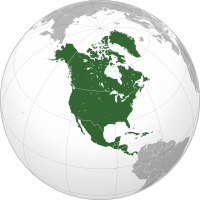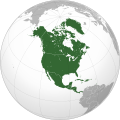
Back ܬܪܥܐ:ܐܡܪܝܩܐ ܓܪܒܝܝܬܐ ARC Партал:Паўночная Амэрыка BE-X-OLD دەروازە:ئەمریکای باکوور CKB Πύλη:Αμερική/Βόρεια Αμερική Greek Portalo:Nordameriko Esperanto Portal:América del Norte Spanish Teemasivu:Pohjois-Amerikka Finnish Portail:Amérique du Nord French प्रवेशद्वार:उत्तर अमेरिका Hindi Portal:Amerika Utara ID
The North America Portal

North America is a continent in the Northern and Western Hemispheres. North America is bordered to the north by the Arctic Ocean, to the east by the Atlantic Ocean, to the southeast by South America and the Caribbean Sea, and to the west and south by the Pacific Ocean. The region includes the Bahamas, Bermuda, Canada, the Caribbean, Central America, Clipperton Island, Greenland, Mexico, Saint Pierre and Miquelon, the Turks and Caicos Islands, and the United States.
North America covers an area of about 24,709,000 square kilometres (9,540,000 square miles), representing approximately 16.5% of the Earth's land area and 4.8% of its total surface area. It is the third-largest continent by size after Asia and Africa, and the fourth-largest continent by population after Asia, Africa, and Europe. As of 2021[update], North America's population was estimated as over 592 million people in 23 independent states, or about 7.5% of the world's population. In human geography, the terms "North America" and "North American" can refer to Canada, the United States, Mexico, and Greenland or, alternatively, Canada, Greenland and the US (Mexico being classified as part of Latin America) or simply Canada and the US (Greenland being classified as either Arctic or European (due to its political status as a part of Denmark) and Mexico classified as Latin American).
It is unknown with certainty how and when first human populations first reached North America. People were known to live in the Americas at least 20,000 years ago, but various evidence points to possibly earlier dates. The Paleo-Indian period in North America followed the Last Glacial Period, and lasted until about 10,000 years ago when the Archaic period began. The classic stage followed the Archaic period, and lasted from approximately the 6th to 13th centuries. Beginning in 1000 AD, the Norse were the first Europeans to begin exploring and ultimately colonizing areas of North America.
In 1492, the exploratory voyages of Christopher Columbus led to a transatlantic exchange, including migrations of European settlers during the Age of Discovery and the early modern period. Present-day cultural and ethnic patterns reflect interactions between European colonists, indigenous peoples, enslaved Africans, immigrants from Europe, Asia, and descendants of these respective groups. (Full article...)
Hamilton is a port city in the Canadian province of Ontario. Hamilton has a population of 569,353 (2021), and its census metropolitan area, which encompasses Burlington and Grimsby, has a population of 785,184. The city is situated approximately 45 kilometres (28 mi) southwest of Toronto in the Greater Toronto and Hamilton Area (GTHA).
Conceived by George Hamilton when he purchased the Durand farm shortly after the War of 1812, the town of Hamilton became the centre of a densely populated and industrialized region at the west end of Lake Ontario known as the Golden Horseshoe. On January 1, 2001, the current boundaries of Hamilton were created through the amalgamation of the original city with other municipalities of the Regional Municipality of Hamilton–Wentworth. Residents of the city are known as Hamiltonians. (Full article...)

Joshua Abraham Norton (February 4, 1818 – January 8, 1880) was a resident of San Francisco, California, who in 1859 declared himself "Emperor of these United States" in a proclamation that he signed "Norton I., Emperor of the United States". Commonly known as Emperor Norton, he took the secondary title "Protector of Mexico" in 1866.
Born in England and raised in South Africa, Norton left Cape Town in late 1845, sailing from Liverpool to Boston in early 1846 and eventually arriving in San Francisco in late 1849. After a brief period of prosperity, Norton made a business gambit in late 1852 that played out poorly, ultimately forcing him to declare bankruptcy in 1856. (Full article...)

The February 2007 North American blizzard was a massive winter storm that affected most of the eastern half of North America, starting on February 12, 2007, and peaking on Valentine's Day, February 14. The storm produced heavy snowfalls across the midwestern United States from Nebraska to Ohio and produced similar conditions across parts of the northeastern United States, and into Canada in Ontario, Quebec and New Brunswick. Significant sleet and freezing rain fell across the southern Ohio Valley and affected portions of the east coast of the United States, including the cities of Boston, Baltimore, Washington, D.C., New York City and Philadelphia.
The southern portion of the storm produced severe thunderstorms with numerous tornadoes reported. One tornado hit a subdivision of New Orleans that was still recovering from the effects of Hurricane Katrina in August 2005. In total, this storm system was responsible for 37 deaths across 13 U.S. states and Canadian provinces of New Brunswick, Ontario and Quebec. The NOAA classified the storm as a Category 3 "Major" storm. The National Weather Service has determined that this storm was one of the three largest snowstorms to hit the inland areas of the northeastern United States since 1940. (Full article...)
Did you know...
- ...that the proposed Atlantica trade bloc would economically tie New England in the U.S. to the Atlantic Provinces of Canada?
- ...that Castillo de los Tres Reyes Magos del Morro (pictured), a fortress which guards the entrance to Havana bay in Havana, was named after the biblical Magi?
- ...that Pico Turquino in the Sierra Maestra mountains is the highest point in Cuba at 6,749 feet?
- ... that Raul Macias, a Cuban-Mexican boxer parlayed his popularity into a successful career in telenovelas?
- ... that during the Dead Rabbits Riot of 1857, residents of Mulberry Street in New York City were forced to barricade themselves in their homes?
Selected panorama

Topics
Categories
List articles
Related portals
Northern America
Central America
Caribbean
WikiProjects
 North America
North America-
 Canada
Canada -
 Greenland
Greenland -
 Mexico
Mexico -
 Saint Pierre and Miquelon
Saint Pierre and Miquelon -
 United States
United States  Central America
Central America-
 Belize
Belize -
 Costa Rica
Costa Rica -
 El Salvador
El Salvador -
 Guatemala
Guatemala -
 Honduras
Honduras -
 Nicaragua
Nicaragua -
 Panama
Panama  Mesoamerica
Mesoamerica Caribbean
Caribbean-
 Antigua and Barbuda
Antigua and Barbuda -
 Bahamas
Bahamas -
 Barbados
Barbados -
 Bermuda
Bermuda -
 Cuba
Cuba -
 Dominica
Dominica -
 Dominican Republic
Dominican Republic -
 Grenada
Grenada -
 Haiti
Haiti -
 Jamaica
Jamaica -
 Puerto Rico
Puerto Rico -
 Saint Kitts and Nevis
Saint Kitts and Nevis -
 Saint Lucia
Saint Lucia -
 Saint Vincent and the Grenadines
Saint Vincent and the Grenadines -
 Trinidad and Tobago
Trinidad and Tobago
Associated Wikimedia
The following Wikimedia Foundation sister projects provide more on this subject:
-
Commons
Free media repository -
Wikibooks
Free textbooks and manuals -
Wikidata
Free knowledge base -
Wikinews
Free-content news -
Wikiquote
Collection of quotations -
Wikisource
Free-content library -
Wikiversity
Free learning tools -
Wikivoyage
Free travel guide -
Wiktionary
Dictionary and thesaurus


























